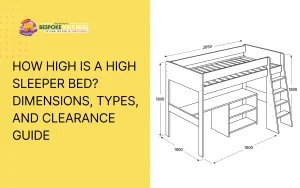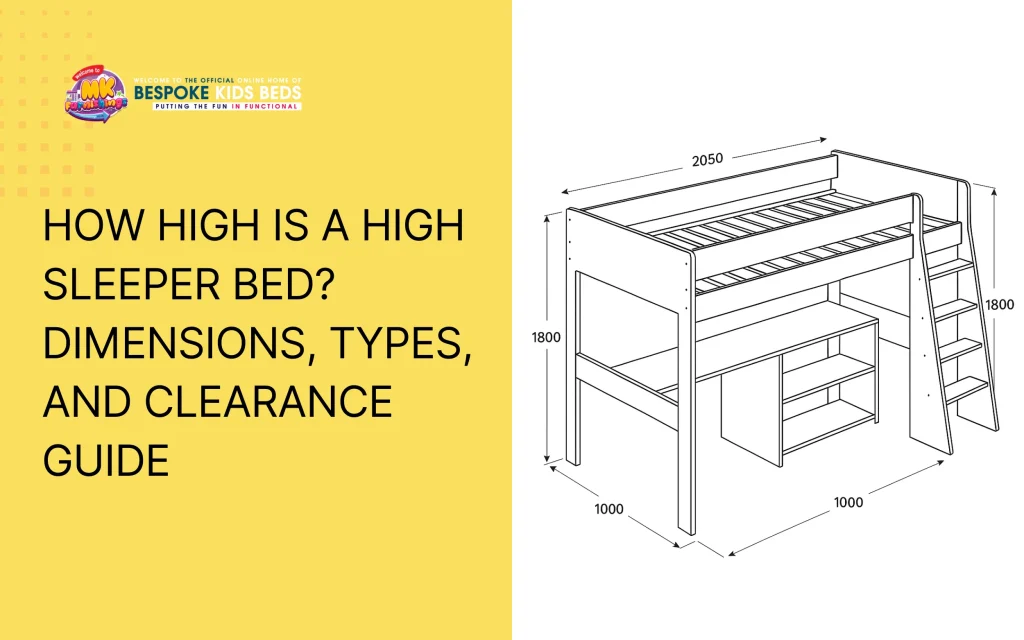
How High Is a High Sleeper Bed?
A high sleeper bed measures between 170 cm and 200 cm in total height, depending on the model and design. These beds create usable space
Enjoy FREE Delivery on All Orders!

A high sleeper bed measures between 170 cm and 200 cm in total height, depending on the model and design. These beds create usable space underneath for desks, wardrobes, or storage, making them an efficient choice for small or shared rooms and a practical feature in a high rise bedroom setup.
The correct height and clearance determine how safely and comfortably a high sleeper fits within your room. Choosing a bed within this range ensures there is enough headroom below the ceiling and provides the right proportions for study or storage space underneath. With proper dimensions, you can create a setup that combines safe sleeping height with everyday practicality.
Bed height is an important factor when planning a child’s or teenager’s bedroom because it affects both comfort and safety. A high sleeper bed usually stands at an average height of around 185 cm in total. This includes both the structure and the mattress, which typically adds around 15 cm. Selecting the right height ensures that you have enough clearance to sit comfortably underneath or climb up safely without feeling confined near the ceiling. Matching these measurements correctly also ensures that the area underneath the bed can be used efficiently for desks, wardrobes, or storage units.
Most high sleeper beds in the UK measure between 170 cm and 200 cm in height.. Compact models closer to 170 cm are designed for smaller bedrooms or younger children, while taller options reaching up to 200 cm often include built-in desks, wardrobes, or shelving underneath. When choosing, consider both the room’s ceiling height and the sleeper’s age. A child’s room with a lower ceiling may suit a shorter model, while a taller frame works well in larger rooms or for teenagers who need more functional space beneath the bed.
The total height of a high sleeper bed is determined by two parts: the frame height and the mattress thickness. The frame usually measures between 160 cm and 190 cm, while the mattress adds another 10–15 cm. This combined height affects both comfort and safety, as it influences how much headroom remains under the ceiling and how high the guardrails extend above the mattress. When selecting a mattress, always follow the manufacturer’s thickness guideline to keep the guardrails effective and prevent the sleeping surface from sitting too high.
Ceiling clearance is the vertical space between the top of the mattress and the ceiling. A standard UK ceiling height of 240 cm is generally suitable for most high sleeper beds, as it leaves about 60 cm of headroom above the sleeping surface. This space allows the sleeper to sit up comfortably and reduces the risk of bumping their head. Before installation, measure from floor to ceiling and account for light fittings or sloped sections that may reduce space. This ensures the bed fits safely and keeps the sleeping area comfortable.
High sleeper beds come in various styles to suit different spaces, ages, and purposes. Some prioritise compact layouts for smaller bedrooms, while others incorporate full study areas or storage for older children or teenagers. The best choice depends on your room size, ceiling height, and how the space will be used.
Mid sleepers and high sleepers differ mainly in height and functionality. A mid sleeper stands around 110–130 cm tall, ideal for younger children who need easier access. A high sleeper ranges between 170–200 cm, offering more space underneath for desks or storage. The choice depends on your child’s age, confidence in climbing, and how much space you need to save.
Low-profile high sleepers are designed for rooms with lower ceilings or where extra headroom is important. These models typically range from 150 cm to 170 cm in height, providing the benefits of raised sleeping space while maintaining safe clearance from the ceiling. They work well in smaller bedrooms or converted lofts and are a practical option for younger users moving from a standard bed to a raised design. This type balances height, safety, and accessibility without compromising on functionality.
High sleeper beds for adults and teenagers are built with reinforced frames, wider sleeping platforms, and secure ladders. They generally range from 180 cm to 200 cm in height and can support weights up to 120 kg or even more, depending on the construction material. These models suit student rooms, studio apartments, or compact flats where space efficiency is essential. The area below often serves as a study or relaxation zone, making them the best choice for older users who need durable, multi-purpose furniture.
High sleeper beds with desks or storage units combine sleep, study, and organisation in one structure. They usually measure between 170 cm and 200 cm in total height and feature built-in desks, wardrobes, or shelving underneath. Some models include corner or pull-out desks, while others offer enclosed cupboards for tidy storage. These designs are well-suited to school-age children and teenagers, helping to keep the room functional and organised without taking up additional floor space.
| Bed Type | Typical Height (cm) | Notes / Description |
| High Sleeper Bed | 170 – 200 | Standard raised bed with space underneath for desks, wardrobes, or storage. |
| Low-Profile High Sleeper | 150 – 170 | Designed for lower ceilings or younger users; maintains safe clearance. |
| Mid Sleeper Bed | 110 – 130 | Lower design for younger children (ages 6–9); includes play or storage space below. |
| High Sleeper with Desk | 170 – 200 | Features built-in or pull-out desks; ideal for study or workspace setups. |
| High Sleeper with Wardrobe | 170 – 200 | Includes enclosed wardrobe or storage beneath the frame. |
| High Sleeper with Sofa Bed | 170 – 200 | Combines sleep and seating space; sofa converts into a guest bed. |
| Themed High Sleeper | 170 – 200 | Styled designs suited for children’s bedrooms. |
| High Sleeper for Adults/Teens | 180 – 200 | Reinforced frame for durability; supports higher weight and daily use. |
Safety and clearance are key considerations when choosing or installing a high sleeper bed. Proper spacing between the mattress and ceiling ensures comfort and prevents injury, while guardrail height and ladder design maintain secure access. Following recommended UK safety standards helps you create a safe environment for children or teens, balancing functionality with peace of mind in daily use.
A ceiling height of at least 240 cm is recommended for most high sleeper beds, leaving about 60 cm of clearance above the mattress for safe and comfortable use. This spacing prevents accidental head contact and supports good ventilation. In rooms with lower ceilings, consider purchasing bed models whose height ranges between 160 cm and 170 cm to maintain safe headroom. Measuring accurately before purchase ensures the bed fits without obstructing lights or ceiling fixtures.
Guardrails are essential safety features that prevent falls during sleep. They should extend at least 16 cm above the top of the mattress, with mattress thickness ideally kept between 10 cm and 15 cm. Exceeding this thickness can reduce the guardrail’s protective height, making sleepers more likely to fall off when they roll around during sleep. Always check the manufacturer’s specifications, as compliant models will specify a maximum mattress depth to meet UK and EU child furniture safety standards.
Ladders on high sleeper beds should be sturdy, secure, and easy to climb. Many designs include angled or vertical ladders that can be positioned on either side to fit the room layout. Non-slip rungs and secure handholds improve safety, especially for younger users. When setting up the bed, ensure the ladder faces an open area with enough floor space for safe access and movement. Proper placement reduces the risk of slips or collisions during daily use.
Families often look for multifunctional bed designs to make the best use of limited bedroom space. High sleeper beds meet this need by combining sleep, study, and storage functions within a single structure. These designs are especially helpful in smaller rooms, where every section must serve a purpose. When choosing, consider the room’s shape, ceiling height, and your child’s age to ensure the setup remains practical and safe as they grow. Common add-ons include:
High sleepers with built-in desks are perfect for school-age children and teenagers who need a defined workspace in compact rooms. These beds often include side or corner desks positioned beneath the frame, giving children and teenagers a quiet place for homework or creative activities. Examples of built-in desks and study areas include:
High sleepers with built-in high bed storage keep bedrooms tidy and make smart use of vertical space. Options such as drawers, pull-outs, and mini-closets help organise clothes, toys, and essentials without cluttering the floor. For narrow rooms, sliding or pull-out storage units work best, allowing easy access while maintaining an open layout. Such add-ons include:
Limited floor space is a common challenge in children’s and teenagers’ rooms, especially in smaller UK homes. A high sleeper solves this by raising the sleeping area and freeing the central floor for play, study, or storage. This vertical layout creates a balanced, open environment that feels larger and more functional. For example, a desk-and-chair setup can fit neatly beneath the bed, or the space can hold storage drawers, a reading nook, or a compact wardrobe to maximise every square metre.
Safety standards recommend that children aged six and above are suitable for high sleeper beds. Younger children may lack the balance and coordination required for climbing ladders safely, especially at night. The raised design means that correct age use is an important factor in preventing falls and ensuring comfortable access. Since raised designs come with falling risks and climbing difficulty, choosing a bed that is fit for a child’s age is essential.
A child’s cognitive and physical development directly affects how safely they can use a high sleeper. Coordination, awareness, and ladder confidence improve with age, making older children better suited to these designs. Always check the manufacturer’s product label or safety guide to confirm the recommended age range before purchase.
High sleeper beds require careful assembly to ensure stability and long-term safety. Most models include step-by-step manuals, and following these instructions closely helps maintain the bed’s strength and balance. However, beds with added features such as desks or wardrobes may take longer to assemble due to extra components and more complex structure.
Common tools required include a screwdriver, Allen key, spanner, and hammer, with the process usually taking two to three hours for one or two people. If assembly feels complex or tools are limited, professional installation is a dependable option. Always confirm that clear instructions and all necessary parts are included before starting.
When choosing a high sleeper bed, focus on key factors such as height, available space, and safety features. The total height of the bed, ceiling clearance, and guardrail protection all contribute to comfort and security. A well-assembled model that fits safely within the room can provide years of reliable use for a growing child or teenager.
Different types of high sleepers suit different needs. Compact designs work best in smaller bedrooms, while larger models with built-in desks or wardrobes suit older children or teens who need dedicated study and storage areas. For rooms with lower ceilings, low-profile or mid sleeper designs offer the same benefits at a safer height. Before purchasing, measure your room carefully and consider how the bed will fit into your family’s lifestyle.
High sleeper frames are made from solid wood, metal, or a combination of both. Wooden frames offer a sturdy and traditional finish, while metal versions provide a modern look and excellent durability.
Most high sleeper beds support between 100 kg and 120 kg quite comfortably, although the frame material and structure may support more weight. Always check the manufacturer’s specifications to confirm the exact weight capacity.
A standard UK ceiling height of 240 cm is sufficient for most high sleeper models. This gives around 60 cm of clearance between the mattress and the ceiling for safe and comfortable use.
The minimum room height recommended is 230–240 cm. This leaves enough space above the bed for sitting up and proper ventilation.
Yes. High sleepers are safe for daily use when assembled correctly and used within the recommended age and weight limits. Safety rails, non-slip ladders, and correct mattress thickness are essential for maintaining everyday safety.
Yes, adults can sleep on reinforced high sleeper models comfortably. Such beds are commonly made from solid wood or heavy-duty metal.
Kyle Kane
Owner
Kyle Kane is Co-Owner of MK Furnishings, a family-run business based in UK that specializes in high-quality custom kids’ bunk beds, including triple, double, single, and themed designs. Since launching the company in 2016 alongside his brother-in-law, Kyle has helped deliver and assemble thousands of beds across the UK, Ireland, and beyond. Focused on customer satisfaction, Kyle leads a hardworking team that handles every step from ordering to delivery ensuring a smooth and professional service. His commitment to quality craftsmanship and reliable support has earned MK Furnishings a strong reputation and growing customer base throughout the region.

A high sleeper bed measures between 170 cm and 200 cm in total height, depending on the model and design. These beds create usable space

The right bed and mattress form the structural base to improve children’s sleep by providing proper spinal alignment and consistent support for their developing bodies.
Fancy £50 off all orders! Enter in 50off to redeem in the coupon code section